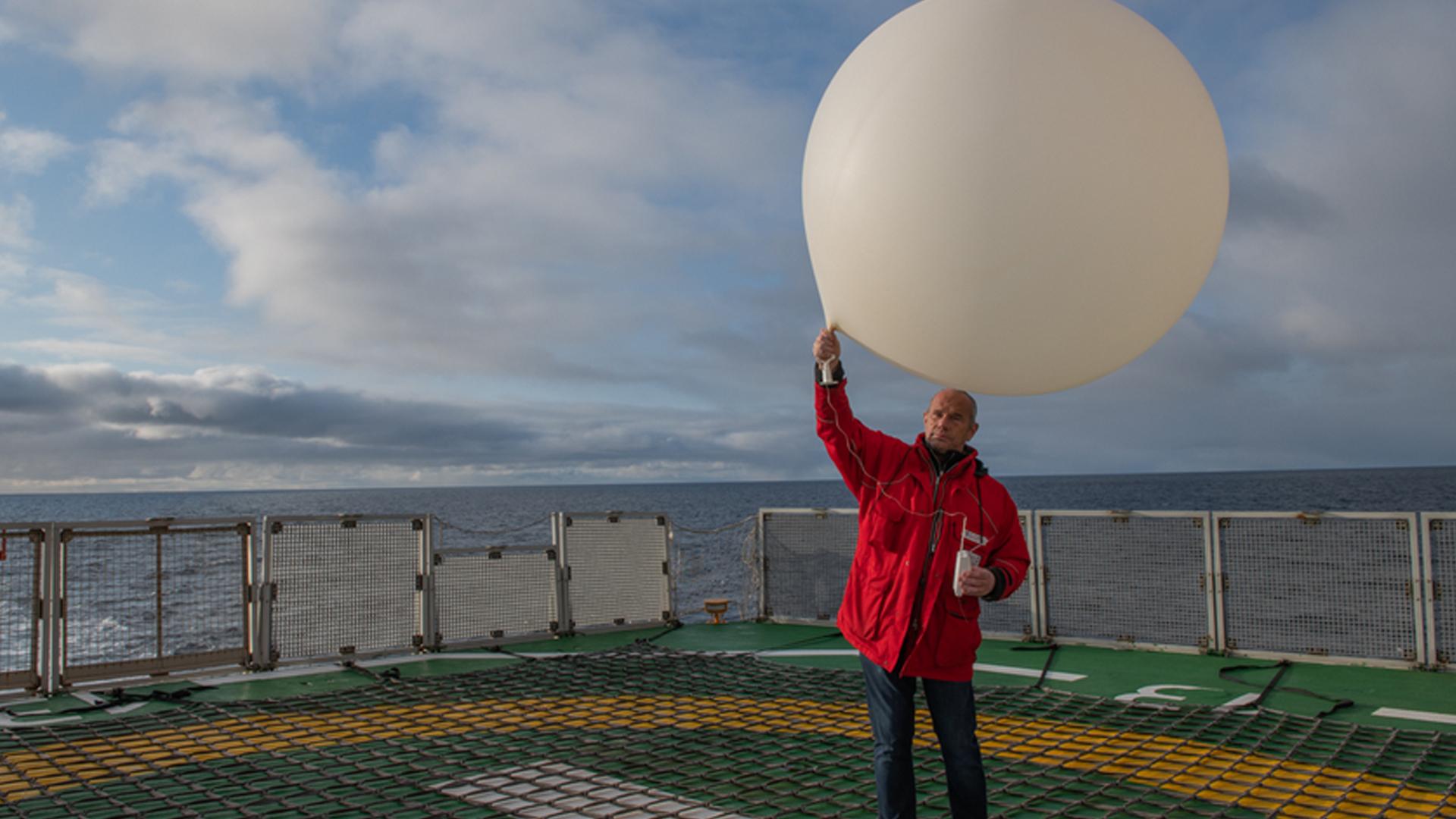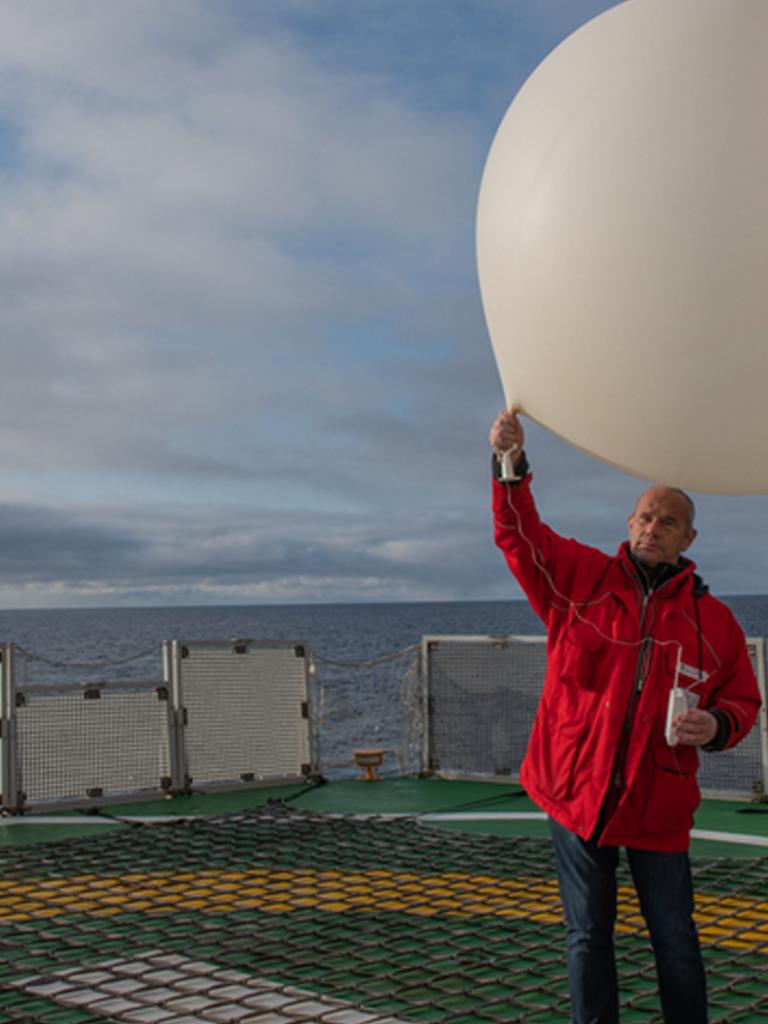
Life as a weather technician on board the Polarstern
Part three of the Polarstern diaries has landed – read on to hear all about life as an on-board weather technician in the latest blog instalment!


Forecasting the weather is an important part of daily life aboard the research vessel RV Polarstern. The students tracking the ship on its current MOSAiC expedition gave us an insight into the on-board weather station.
17 May 2022
28 April 2020
Blog three
Keeping an eye on the weather
Authors: Jan Kärger, Kevin Schmidt and Antje Wagemann.
The weather stations on board research vessels are special working environments with their own unique challenges and tasks aside from the usual daily routine.
The weather station situated on the Polarstern is managed by two people. One of them is a meteorologist and the other, a weather technician. Together, they are responsible for ensuring safe flight operations, protecting the ship itself from weather-related damage/downtime and optimising scientific usage, because most of the scientific experiments are weather dependent.

The weather technician especially has a much broader range of duties on board than on the mainland. Primarily, they are responsible for delivering continuous weather observations and for providing the meteorologist with the latest observed weather/numerical forecast data, which is today almost exclusively done by email from a station on the mainland (e.g. for the RV Polarstern: the Deutscher Wetterdienst (DWD) or marine meteorological services in Hamburg take care of this). The weather forecasts are made twice a day by the meteorologist.
Apart from carrying out weather observations, the weather technician has to gather and archive all meteorological parameters and to monitor the meteorological measuring systems.
This is achieved by looking at the recorded data within tables and diagrams. In case of irregularities, they have to figure out why they exist and must try to correct or repair the measuring systems.
Moreover, the weather technician performs weather, sea and ice observations every three hours and does four daily soundings using weather balloons, which take place on the helicopter deck at the main observation times (00:00, 06:00, 12:00 and 18:00 UTC). Andreas Raeke, who works as a weather technician on the Polarstern, emphasises that in the case of announced flight operations, an additional sounding will usually be carried out in order to optimally support in-flight weather consulting.

All data collected by the soundings and weather reports are brought into the global telecommunications network (GTS) of the World Meteorological Organization (WMO) via satellite. These data are special and come from the most remote areas of the world, where the weather station network is very thin. They are filling the gaps in the global monitoring network and thus contribute to the data assimilation and improvement of the numerical weather forecast models. Moreover, the data are also processed for the climate archive. The continuous automatic data input and merging of all instruments on board, in the form of numerical values and diagrams, are also available for all scientists and staff members via the on-board data system. Sometimes, scientists need the help of the weather technician because they need the latest weather information for planning their outdoor activities, or they need special additional soundings (radiosonde, ozone etc.).
When the weather technician sleeps, the automatic computer system takes over as much as possible (skills are limited).


Figures 3 & 4: Measurement tools on the deck of RV Polarstern, source: Antje Wagemann (HS39)
Differences to the work on the mainland – physical and psychological strength
Our interview partner Andreas Raeke talks about the special challenges that one has to face on the Polarstern: “In rough seas, you have to take care of all objects in your office. Everything must be secured against slipping. This applies to coffee mugs and computer screens, as well. Some people also experience some sea sickness. If your weather forecast fails, you will be the first one to realise and at breakfast time you cannot run away from the direct feedback of the ‘customers’.”
An average day for a weather technician on the Polarstern
Working on a research vessel includes special working conditions. The scientists are working around the clock and the latest data from the atmospheric situation is needed for setting up their measuring systems/experiments and for the evaluation of the samples.
In order to meet these demands, the workday starts at 05:45 every day, including Saturdays, Sundays and holidays. Andreas Raeke explains: “At first, one has to check the devices to see if everything is working properly. Then one provides the meteorologist with the latest observed weather data and numerical forecast data which already arrived by email. After that, the weather technician releases the weather balloon on the helicopter deck and observes the weather, clouds, visibility, state of sea and ice. Finally, the complete observation including the automatic measurements are transmitted via satellite.”
Over the course of the day, the weather is monitored intensively during flight operations with the use of the helicopters. Incidentally, the collection of data is also contributed to by releasing a weather balloon every six hours.
The most important meeting every day is in the evening, when all members of the expedition come together for a summary of the day and an outlook of the forthcoming tasks. During these meetings, the weather presentations of the meteorologist, which are based upon the observation data of the weather technician, play an important role for planning all activities.
Of course, there are also regular breaks including tasty meals and some downtime which people often use to do sports or to meet other scientists/crew members in one of the saloons on board.
Apprenticeship
To become a weather technician you have to take on a versatile apprenticeship. You can get educated as a technical assistant for meteorology as well as a weather observer at one of the national weather services (in Germany for example, it’s the DWD). In the past, you also learned how to perform radio recordings and listen to Morse code on a ship. In Germany, there are only a few representatives of this profession.
About our interview partner - Andreas Raeke
Andreas Raeke did an apprenticeship as a technical assistant for meteorology in Potsdam and worked for different departments within Germany. He also got the chance to visit the Georg Forster station in Antarctica. After he had been travelling a few years on board the research vessel Meteor (since 2009), he changed to the on-board weather station of the RV Polarstern. In December 2011, he participated in a cruise from South Africa to the German Antarctic station Neumayer.
The main part of the research took place in the Weddell Sea before they finally arrived in Punta Arenas, Chile in January 2012. In July 2018, another expedition took him from Bremerhaven to the Fram Strait between Spitsbergen and Greenland, ending in Tromsø, Norway and in June 2019, he went on a transit cruise from the Falkland Islands to Bremerhaven.
Sources:
- Interview with Andreas Raeke, a weather technician on Polarstern in September 2019
- Book: “Polarstern 25 Jahre Forschung in Arktis und Antarktis”
- Interview with Klaus Buldt